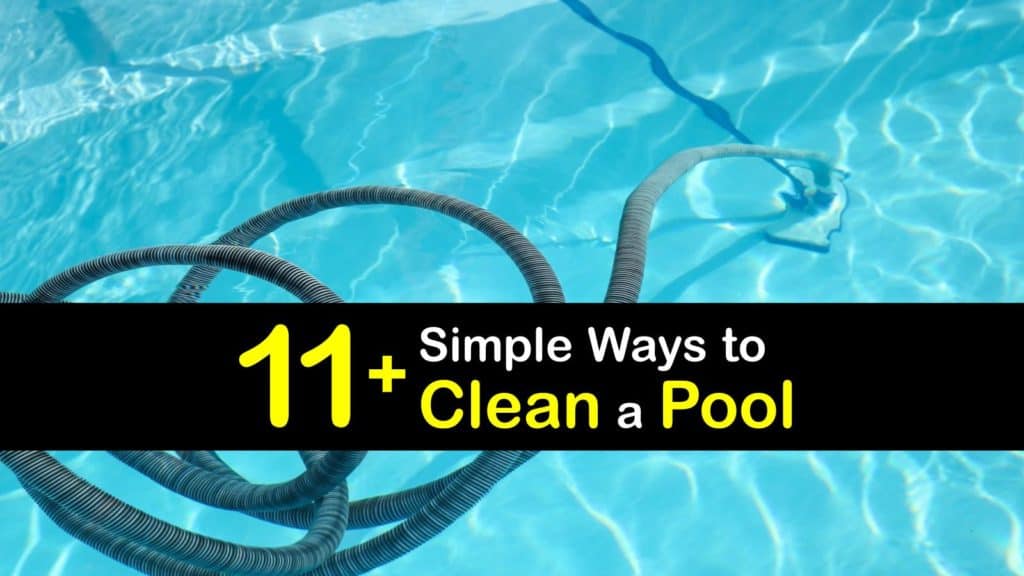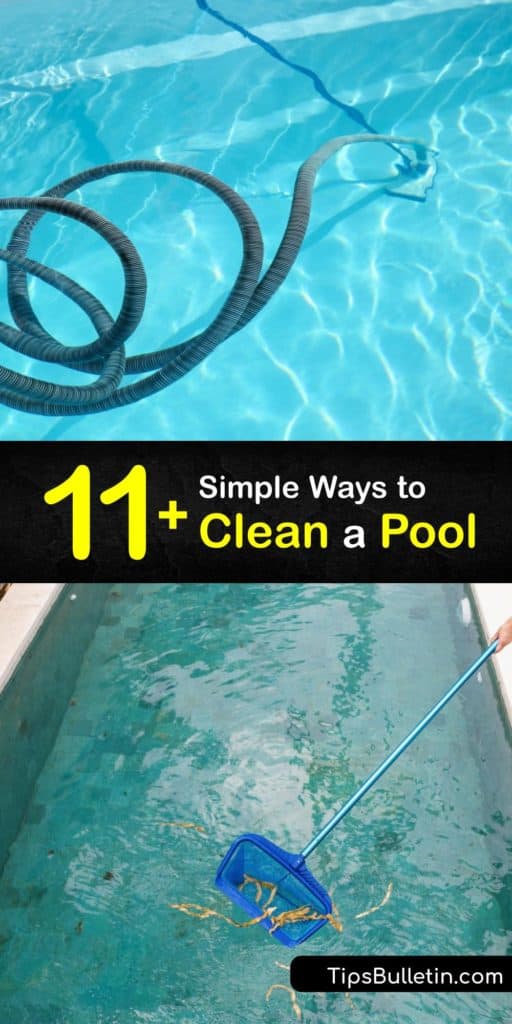There is nothing more delightful than cooling off in your own swimming pool on a hot summer afternoon. However, pools are also a magnet for leaves and dirt, and it’s vital to maintain them regularly to prevent algae growth. We show you how to clean a pool to keep it free of debris and safe for everyday swimming.
Pool maintenance is vital when you own a swimming pool, whether it’s a small, portable pool or an in-ground pool. The easiest way to keep the pool clean is to hire a pool cleaning service.
However, many pool owners agree that this is costly and prefer to take care of the cleaning job themselves.
While the task of cleaning your own pool seems daunting and time-consuming, it’s easier than you think. The key is to use the proper tools, pool chemicals, and cleaners for the job. Once you set up a routine, the job becomes simple.

- How to Clean and Maintain a Swimming Pool
- Why Pool Cleaning and Maintenance are Important
- How to Clean Stains on Bottom of Pool
- How to Clean a Pool with a Leaf Skimmer
- Cleaning the Sides of the Swimming Pool
- How to Vacuum the Swimming Pool to Remove Debris
- Testing the Pool Water pH Levels
- How to Check and Clean the Pool Filter
- Using Chlorine Tablets to Clean Your Pool
- How to Shock a Filthy Swimming Pool
- Cleaning the Swimming Pool Floor without a Vacuum
- Ways to Clean a Cartridge Style Pool Filter
- Ways to Prevent Your Swimming Pool from Getting Dirty
How to Clean and Maintain a Swimming Pool
While pool cleaning is not high on the list of fun things to do, not cleaning the pool water creates a build-up of algae on bottom of the pool as well as on the walls, and causes filter clogging.
We explain the different steps in the cleaning process and how to maintain your pool to keep it clean.
Why Pool Cleaning and Maintenance are Important
Pool cleaning is essential for more reasons than simply keeping the water free of fallen leaves and debris. Your swimming pool is an asset, and maintaining it regularly not only improves aesthetics but helps it last longer.
Importance of Pool Care
Keeping your pool clean means you and your family get more enjoyment out of using it. Dirty pools get clogged drains which eventually burn out the pump motor.
Pool water that is not cleaned regularly gets a green tint, which is a sign of algae growth. You may even find that your swimming pool turned green overnight. An unclean pool may contain bacteria, and swimming in filthy water leads to skin rash, eye infection, respiratory irritation, and other health problems.
How to Clean Stains on Bottom of Pool
There are several reasons for pool stains in a concrete pool, including algae, dirt, and calcium build-up. The best way to clean stains on bottom of pool is to brush the surface with a pool brush.

Follow the instructions for your granular shock treatment product and sprinkle the granules over the floor stain.
The treatment bleaches away organic material and makes them seem to disappear. Use a pool brush to remove calcium deposits from swimming pool tiles by scrubbing the spots first. Then, turn on the pool filter to flush away loosened dirt. Follow the same procedure to kill green algae on pool walls, too.
How to Clean a Pool with a Leaf Skimmer
The first step in pool water cleaning is to remove all the leaves, dirt, and other floating debris from the water’s surface. It’s essential to perform this routine daily to prevent clogging in the filter system and keep the water clean.
Attach the leaf skimmer net to a telescopic pole to reach the furthest areas of the water. Skim the surface with the net to pull out the leaves and foliage and remove the excess debris as needed while you work.
Begin at one side of the pool and make your way across to the other side as you clean the water surface.
Cleaning the Sides of the Swimming Pool
The next step in pool cleaning is to clean the pool sides at the water level and ladder with a brush since these areas are magnets for attracting stagnant dirt and grime. It’s a good idea to perform this step weekly to keep these areas clean.
Position a pool brush on the end of a telescopic pole and use some force to brush the stairs or ladder clean. Next, clean the inside wall of the pool by brushing the surface edge. Apply some elbow grease as you work your way from one side of the pool to the other.
How to Vacuum the Swimming Pool to Remove Debris
The bottom of your pool requires cleaning at least once a week, and there are a variety of pool vacuums that work well to get the job done. They suck up loose dirt and work wonders to clean stains on bottom of pool.
While we’d all love to have a robotic pool cleaner, it is often quite expensive. If you don’t have an automatic pool cleaner, then it’s time to get vacuuming with a manual vacuum for removing dirt from bottom of a pool.
The way to vacuum a pool starts by attaching the vacuum head to the telescopic pole. Lower the vacuum head into the pool while feeding the hose into the water.
Remove all of the air from the hose and attach it to the pump. Vacuum the bottom of the pool in the same manner that you vacuum your home carpeting by moving it back and forth, section by section, until the floor is clean.
Testing the Pool Water pH Levels
Cleaning a swimming pool is essential, but checking the pH level is just as important. Everyday use and weather affect the chemical levels that help keep the water clean, and monitoring the level helps you make proper adjustments.
Pool Chemical Management
Purchase a pH test kit at an online shop or your local pool store and test your pool three times a week. Take a water sample about 12 to 18 inches below the surface and follow the instructions for your kit.
The pH level of the water should be between 7.2 and 7.8 with a free available chlorine level of 2.0 to 4.0 ppm, total alkalinity of 80 to 120 ppm, a bromine level of 5 ppm, and a cyanuric acid level of 30 to 50 ppm.
How to Check and Clean the Pool Filter
Your pool’s filter system helps to keep the swimming pool water clean and sparkling. The pool pump circulates water through a filter to remove bits of dirt and debris, and it’s vital to check the filter regularly to keep it running smoothly.
Pool Filter Cleaning
The best way to clean a pool filter is to first check the filter regularly by pulling it out of the housing. Inspect it for large debris, such as leaves and other bits of material. If it appears dirty, take it out, clean it, and remove the pieces by hand before replacing it.
Unlike cleaning hot tub filters with vinegar, there are other ways to clean your pool filter. A brisk hosing down is usually enough to do the trick.
Using Chlorine Tablets to Clean Your Pool
Sanitizing chlorine tablets are necessary for keeping your pool’s water free of germs and bacteria. These tablets are easy to use and available at most hardware or online stores.
Follow the instructions for your chlorine tablet sanitizer and add the appropriate amount of tablets according to your pool’s size. Place them in an automatic feeder, skimmer basket, or floater. They dissolve slowly and kill bacteria in the pool water.
How to Shock a Filthy Swimming Pool
Over time, sweat, urine, and hair cause bacteria to grow out of control and contaminate the water. If your pool is so filthy that the water is turning green, it needs a shock treatment to get it back in working order. Shock is best for cleaning a green pool fast.
Pool Shock
Follow the directions for your brand of pool shock and disperse the powder over the course of a few days.
Start with three to four gallons of shock and check the water the following day to see if you need to clear up a cloudy pool or if the water is crystal clear. If it’s still green, do another shock treatment and check again in 24-hours.
Cleaning the Swimming Pool Floor without a Vacuum
After you balance the water’s pH level and the water is clear, it’s time to finish up by cleaning the pool floor. Here is how to clean the floor of your pool if you do not have a vacuum.
Begin by removing the large bits of debris by hand. Doing this requires getting wet, so slip on a bathing suit and choose a nice sunny day to get started.
Use a pool brush to loosen the small bits of dirt from the bottom, making sure to work the brush along the edges and corners. Once the debris is off the floor and floating in the water, turn on the filter pump and let it suck out the dirt.
Ways to Clean a Cartridge Style Pool Filter
The pool pump and filter are necessary tools for your swimming pool. They remove bits of dirt out of the water, so you don’t have to spend so much time cleaning the pool.
But, it’s necessary to clean or replace the cartridge as needed to ensure the system runs appropriately.
A pump filter pressure of seven pounds or more above normal indicates that it’s time to remove and clean the cartridge. If your filter is capable of backwashing, set the backwash valve to the appropriate setting to clean the filter.
Otherwise, turn off the pump and water supply and release the air relief valve. Open the compartment and pull the filter out by releasing the clamp.
Inspect the pool filter for damage such as holes and tears, and replace it if necessary. Otherwise, use a garden hose to clean the filter by spraying between the pleats from top to bottom.
Once it’s clean, let it air dry completely, give it a good shake to remove dried debris, and then replace the filter into the compartment.
Ways to Prevent Your Swimming Pool from Getting Dirty
We’d all rather spend more time splashing and cooling off in the swimming pool than cleaning it. Here are several tips for keeping your pool water sparkling clean without having to work up a sweat.
If possible, cover your pool with a pool cover when it’s not in use to keep blowing dust, dirt, leaves, and insects from getting into the water. If your pool is portable, consider placing it in an area of the yard where it’s not beneath trees.
Measure the water’s pH level regularly to prevent it from being too acidic or alkaline, and use a leaf skimmer daily to clean the surface. Attach a skimmer basket to the inside of the pool to catch leaves and dirt while the pump is running.
Swimming pools offer a fun way to cool off during the summer months, especially if you live in a hot climate. But, not everybody has access to a service to clean a swimming pool.
Fortunately, there are simple ways to clean the pool and filtration system to remove contaminants and maintain the water for safe swimming.

Now that you’ve discovered how to clean a pool to fill your summer days with leisure time relaxing in the refreshing water, why not share our swimming pool cleaning guide and tips with your social circle on Facebook and Pinterest?